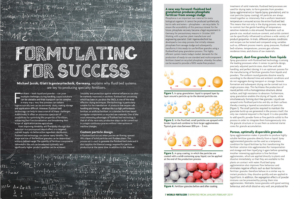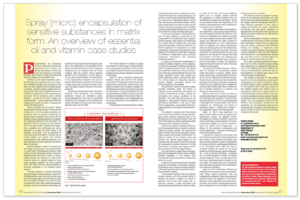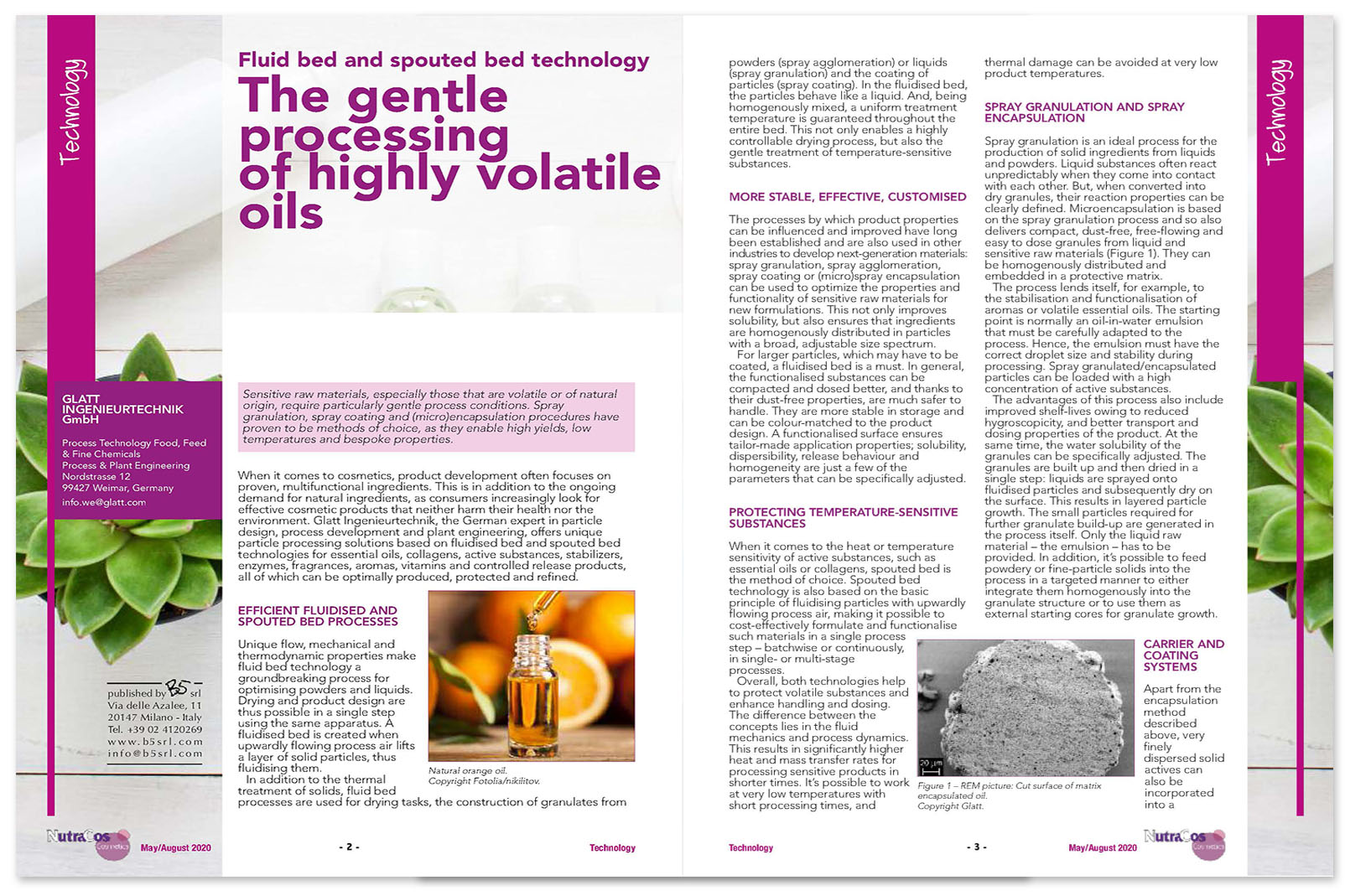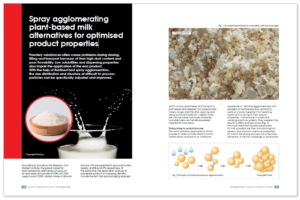Fluid bed and spouted bed technologies – Optimising functional ingredients for enhanced nutrition
Fluidised bed and spouted bed processes by Glatt offer manufacturers almost unlimited possibilities in terms of optimised particle design and the functionalisation of ingredients, the properties of which can be fine-tuned using spray granulation, agglomeration, micro encapsulation and coating.
- Author: Claudia Heck, Catchay Communications
- originally published in the trade magazine ‘Innovations in Food Technology’, issue 11/2020
- Food & ingredients December 2022 (yumpu.com)
The consumer demand for fortified products is constantly growing and has been well received by end users. The form in which health-promoting probiotics, dietary fibres or antioxidants are consumed depends on both the preferences and everyday habits of the individual: some prefer sports drinks, protein bars or enriched iced tea, whereas others favour more direct dosage forms, such as effervescent tablets, sachets or capsules. However, although the manufacturing processes associated with these products present numerous challenges, a universal requirement is that functional ingredients must be stable during storage, precisely dosed, dissolve quickly or have a depot effect. Key factors are excellent flow properties, the absence of dust and a precisely adjustable bulk density; they must neither lump nor separate.
Fluidised bed processing is ideally suited to the large-scale production of these ingredients. In many branches of the industry, fluidised bed technology is used to agglomerate powders, dry liquid ingredients into granulates or pellets, encapsulate them in microcapsules and, if required, encase them in a functional coating. In food applications, ingredients are typically subjected to a moderate heat of 30–50 °C to preserve their functional and nutritional properties. Further key parameters are short retention times and higher heat and material transfer rates, which facilitate the gentle handling of temperature-sensitive materials.
Glatt Ingenieurtechnik, Germany, is one of the leading suppliers of integrated plant solutions and, as an engineering service provider, knows how to tackle these issues. Together, the engineers plan and develop fluidised bed and spouted bed systems for the food, feed and chemical industries. Glatt’s technologies enable manufacturers to optimise the properties of a wide range of products (Fig. 1).
Fluidised bed principle
Both fluid bed technology and spouted bed technology are based on the principle of fluidising particles using an upward-flowing process gas. These systems comprise the inlet gas chamber, the process chamber, the spray system and filtration apparatus. Also used to bulk dry a variety of materials, both technologies make the process more efficient by suspending the material to be dried and exposing its entire surface to the process gas. The main difference between fluid bed and spouted bed is the design of the process chamber (Fig. 2, 3).
Spray granulation: from liquids to granules
Fluid bed spray granulation is an efficient process option to convert liquid raw materials directly into free-flowing, compact and dust-free granules. Spray granulation enables granule formation and release control to be done in a single step. During spray granulation, liquids are sprayed onto fluidised particles, which dry on the granule surface and thereby create a layered accumulation of particles. With the help of spray granulation, it is possible to dry liquid food additives — such as stabilisers, flavours, vitamins or sweeteners — while precisely adjusting their particle size, residual moisture levels and solids content, resulting in round pellets with excellent physical properties.
Microcapsules: depot effect
Fluidised bed spray coating is the method of choice when the optimisation of product properties involves, for example, controlled release mechanisms, modifying the surface structure for higher thermal and oxidation stability and/or also masking odours or flavours. Microencapsulation is also based on the principle of granulation. The matrix material forms the carrier and the active substance is physically embedded in the solidified particle structure. With the inclusion of an active substance in a solid matrix, microcapsules provide an ideal vehicle to control and protect vitamins, flavours or polyunsaturated fatty acids (PUFAs), as well as volatile essential oils.
Coating: functional surfaces
Film or hot-melt coatings are well proven solutions that enhance important requirements such as long-term stability, resistance to oxidation and targeted release. A functional film coating not only provides a smooth layer that makes capsules easy to swallow, it also offers a protective barrier against light and moisture. A functional surface layer can be created that, depending on the pH, either partially or completely dissolves, offering slow, targeted or controlled release mechanisms for specific ingredients. Moreover, coatings can mask the undesirable tastes associated with certain ingredients — such as vitamin and mineral mixtures — that often have a metallic or astringent taste if mineral salts are used.
Spray agglomeration: perfect solubility
Spray agglomeration is used to convert powdery raw materials into homogenous easy-to-disperse (instant) products in a single process step. For example, fluidised bed spray agglomeration, whether used in batch, continuous, single- or multi-stage mode, involves spraying a liquid into a fluidised bed and forming liquid bridges between the colliding particles. The liquid bridges are dried and solidified; as such, the fine powder is transformed into coarser agglomerates with a larger grain structure and improved application properties. The stable bonds reduce the risk of breakage and abrasion during handling, processing and storage; plus, the final product is dust-free, free flowing and can be precisely metered. The porous structure of the agglomerates determines its improved wetting and solubility behaviour, which defines the ease of use and, ultimately, commercial success of a product.
Adhesive forces
Certain formulations can be agglomerated using water as the binding agent, which generates sufficient liquid bridges by moistening and partly dissolving the surface of the powder. The advantage of using water as a spray medium is that no binding agents have to be mixed, stored or added, and the cleaning of the spraying system is easier with regard to product changeover and hygiene. If harder, more stable particles are required — as a prerequisite for further processing, for example — this can be controlled by binder substance viscosity, process time and temperature profile.
By selecting the appropriate spray medium (composition, viscosity, temperature and concentration), a variety of effects can be achieved. Spray fluids with high viscosities improve the internal structure of instant products and ensure they disperse more easily. In principle, organic substances can also be spray agglomerated to improve the consistency of sauces or the rehydration capability of starch, for example. Raw materials with oily components such as chocolate powder require an emulsifier for better dispersion. Inorganic substances can be used to agglomerate a wide range of components and mixtures for fine chemicals.
Cans, capsules and sachets
Fluidised bed spray agglomeration is an important process for substances destined for solid dosage applications, such as vitamin formulations and dried probiotics. Like minerals and micronutrients, their particle structure, moisture and bulk density must be adjusted according to the application. When filling into cans, capsules or sachets, or compressing into effervescent tablets, reproducible product properties such as blend uniformity, flowability and particle size have to be ensured. Sports drinks often require the protein powder to have a low bulk density and a high porosity. High wettability ensures that the particles disperse or dissolve rapidly without residue when mixed in water, milk or plant-based drinks. This also applies to sugar substitutes such as polyols, including xylitol, maltitol or lactitol, for the production of calorie- and sugar-free foods and drinks. Components for premixes and raw materials with added value can also be prepared for industrial production processes using spray agglomeration.
From lab scale to industry scale
It is generally recommended that initial tests are done on a laboratory plant with lower quantities of raw materials. With the help of in-process analyses of the active substance or other important particle characteristics — such as size and bulk density — procedures can be quickly adapted to obtain the desired product properties. Taking an individual approach to each project, Glatt designs, develops and delivers plant that is customised to meet specific customer requirements. Based on its extensive consulting experience, Glatt offers comprehensive engineering services as well as entire turnkey solutions. Process technologies are often initially assessed in small-scale laboratory units. Then, based on demand and the formulation, the company determines the optimal operational parameters in pilot studies, facilitating reliable scale-up (Fig. 4).
Access to innovative technologies
Available at the company’s technology center in Weimar, Germany, Glatt offers a wide range of laboratory and pilot plant for early stage trials and testing. For new particle and product forms, customers benefit from short development times without having to invest in new technology or additional personnel. The state-of-the-art equipment provides a fast and reliable way to obtain results for feasibility studies, product requirements and sample quantities for performance evaluation or marketing. Based on interdisciplinary knowledge and decades of experience in the modification and optimal combination of process parameters, ingredient manufacturers can rely on Glatt to deliver cost-effective results. In addition, they can minimise risk by using cutting-edge engineering from a single source. Up to the plant commissioning stage, Glatt offers contract manufacturing services that fill any in-house production gaps and expedite time-to-market. From initial idea to the finished product or production plant, the company provides a flexible and competent interface throughout the entire value chain (Fig. 5).
Further information on this topic and related topics can also be found in the following publications:
Published article: ‘Fomulation For Success – Fluid Bed Systemes as Key for the Production of Speciality Fertilizers’, PDF, English
Published article: ‘Spray (micro)encapsulation of sensitive substances in matrix form – An overview of essential oil and vitamin case studies’ PDF, English
Published article: ‘The gentle processing of highly volatile oils by fluid bed and spouted bed technology’ PDF, English
Published article: ‘Spray agglomerating plant-based milk alternatives for optimised product properties’ PDF, English
Published article: ‘Process Technologies to Optimize Detergent Manufacturing’. PDF, English







 Copyright: B5 S.r.l., Italy
Copyright: B5 S.r.l., Italy Copyright: LT Food Medien-Verlag GmbH
Copyright: LT Food Medien-Verlag GmbH